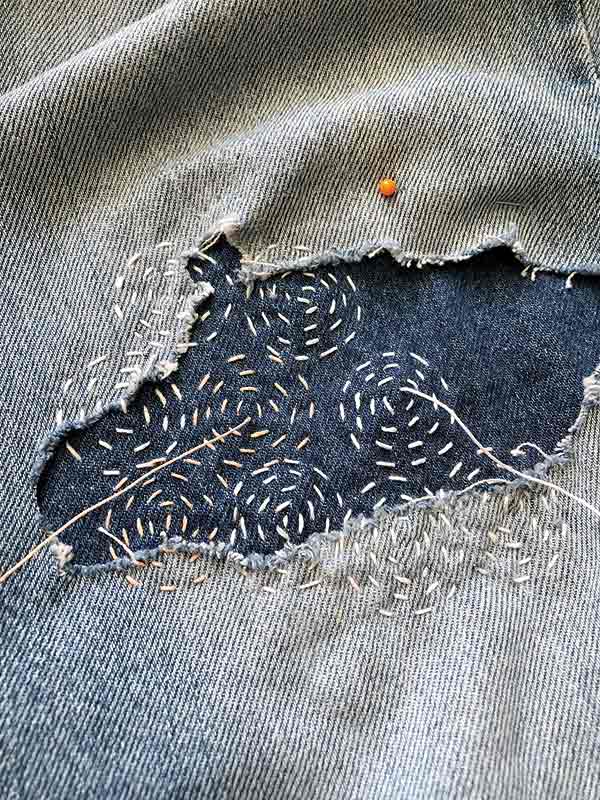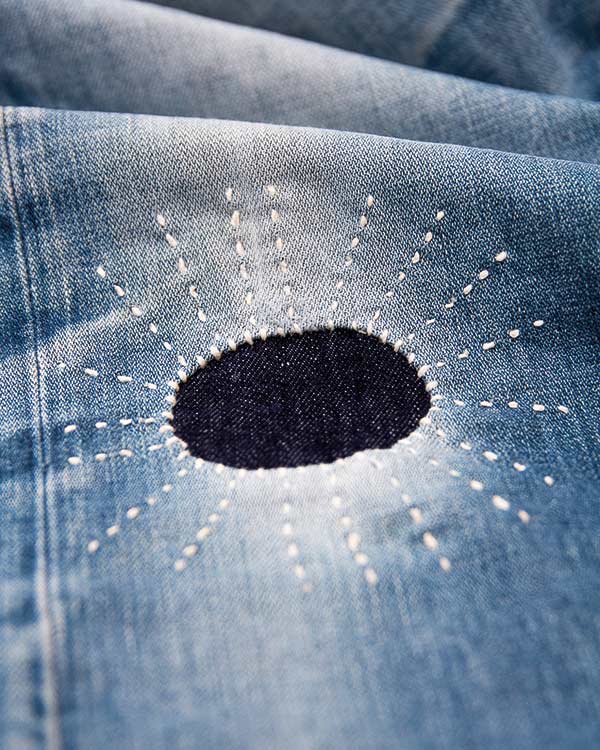Subtotal: $
Checkout
The Joy of Mending Jeans
A mom makes mended clothes beautiful.
By Leah Libresco Sargeant
January 3, 2024
Available languages: Deutsch
For Grace Russo, a mother in Westminster, Maryland, mending clothes is both a quotidian chore of stewardship and an invitation to contemplation. Inside her home, she patches clothes with exuberant needlework, which overspills the original damage and overruns the garment. Outside, she applies her training as a master gardener to decide which acts of human creation honor the natural world and which must be ripped out by the roots.
Russo became interested in mending when she was in graduate school, where she had little space in her budget for new clothes when hers got too thin or damaged. The clothes that most needed mending were the ones she had worn most – “I had a lot of plaid flannel shirts that were fraying at the cuffs or losing their seams,” she says. It’s the most loved daily clothes that need repair while the poorly-suited-to-you dress hangs pristine at the back of the closet.
Russo had always liked making art, and she was drawn to embroidery as a way to doodle and draw with thread. The first book she read on decorative embroidery was by a Japanese artist, which eventually led her to discover sashiko.
Sashiko is a Japanese hand-quilting technique that can be used purely as ornament or as a way to add a patch to a worn piece of fabric. The technique traditionally uses white thread on indigo fabric, making the mending bright and noticeable. The stiches usually appear all the way across the patch, not just at the edge to bind it into place. It turns the entire patch into a canvas for geometric or nature-inspired patterns.
Russo mends her husband’s cotton button-downs with little rivulets of colorful thread. As the shirts get old enough to show wear, they also are finally old enough to be soft and wonderful against the skin. It takes mending to keep them in circulation when their material has reached its best quality.

Photograph by Erin Eggenburg. Used by permission.
When Russo began repairing her clothes, it changed what kinds of new clothes she wanted to buy. When she looked at something on the rack or at a thrift store, she didn’t just consider how the outfit looked then, but how it would change as it aged and weakened. What kind of mending would it need and what kind of repairs could it support?
She looked for thicker cotton fabrics that could stand up to strong stitches. She avoided clothes made of stretchier synthetic fabrics – she didn’t like the idea of wearing petroleum products, but more than that, they didn’t take repairs gracefully. She even wound up checking online reviews of clothes to see what kind of seam was hidden inside a dress before ordering it. A straight stitch in a stretchy maternity outfit was much more likely to rip than a zigzag.
As she looked at each seam, imagining how she might one day pass it back through a machine, she had a stronger sense of the hands that had already guided it, inch by inch, into its present form. Until she took up sewing herself, Russo imagined that a lot of clothes manufacturing was automated in the ways spinning thread had been. But there are almost no sewing machines that work alone. The needle is pumped up and down by a motor, but human hands guide the cloth around its turns. There is nothing woven that we put on our bodies that hasn’t passed through someone’s hands, usually half a world away.
Russo wants her girls to have a deeply rooted sense of the work and intention that each act of creation requires.
Not everything can be repaired, or, in Russo’s judgment, should be. There are items that are ready for the rag bin, and others that she puts aside indefinitely. She could fix them, but only at the expense of her other responsibilities. “I’m balancing the amount of work and the emotional weight of the garment,” she explains. Some badly damaged clothes might get tucked at the bottom of the mending basket, where they are held in hope of a change of season, more independence for the girls, a stretch of time to let the rips bloom into beauty. Some will become patches themselves.
Repair is natural and necessary for her children’s clothes. She tries to buy well-made clothes and then turn her daughters loose to explore and be active – which means their dresses make frequent trips to the laundry and mending baskets. Her oldest, Beatrix, is three, and Russo finds ways to let her participate in making whole what her play has torn.
Russo dips the needle in and out of the cloth, Beatrix pulls the thread through till it’s taut. She sits beside her mother to work with her own needle on a lacing card. Russo’s goal is that each of her girls “grows up with an awareness that creating things takes work, things don’t just appear.”
A home is not a factory floor, but it’s easy for the work of mothering and homemaking to slip behind the same veil of effortlessness that companies use to conceal the skilled labor required to create our clothes. Russo wants her girls to have a deeply rooted sense of the work and intention that each act of creation requires. The girls should have nimble fingers, quick to pick something up to mend but also eager to reach up and pull away the scrim that makes makers invisible.
When Russo takes her girls out to play, she looks with a gardener’s eye, seeing not just greenery but the (often strained) relationships between flora and fauna. In 2020, Russo was pregnant and isolated by the Covid pandemic. She wanted to go out into nature and explore, and found the master gardener program run by the Maryland State Extension Service. Covid meant the classes were offered online, and she and her husband curled up on the couch together, baby eventually snuggled up between them, to learn about soil composition and restoring native plants.
Our world can’t be remade new from whole cloth. Instead, Russo tries to scaffold up better systems that are more resilient.
The program ends with a lengthy exam – and the requirement to pledge to put your new certification at the service of your neighbors. Master gardeners put in volunteer hours at farmers’ markets, 4H fairs, and more. Russo has run games involving soil for little children. When she spotted poison hemlock in a churchyard, she noted the address and sent in a message warning of the danger.
Repairing the ecosystem, whether at the scale of a yard or a neighborhood, is slower work than darning a sock. At the house where Russo lives, there are non-native plants she and her husband ripped out immediately, and others that were so deeply rooted that she decided to live with them. A Norway maple is invasive, but “if you move into a house with a thirty-year-old maple, it doesn’t make sense to chop it down and put in a three-year-old sapling.” Instead, she looked up shade shrubs that were natives and would welcome the protection of its branches.
When a sleeve of her gardening clothes rips on a thorn, the mending won’t make it look like nothing happened. And when homeowners and city planners have worked against the grain of the earth for generations, “we’re at a point with our ecosystem where it’s never going to look like nothing happened.”
Our world can’t be remade new from whole cloth. Instead, Russo tries to scaffold up better systems that are more resilient. When working with garments, “you see the weak points and try to build them up so that they’re just as strong as, or stronger than, the part around it.” She faces the same challenge with gardens – what here needs help to be resilient under tension?

Photograph from Second Sunrise. Used by permission.
Russo’s approach to repair is bracing for someone, like me, who approaches fixing as making things exactly as they were. In a garden, I know how to weed and remove unwelcome plants, but I don’t know what to add. What she does requires a particular artistic sensibility – not just seeing how something was and returning it to its standard, but imagining how it might be, and letting it gently drift away from factory settings.
So where would someone with little or no experience begin? Try expanding the canvas of what you’re working, Russo advises. If you’re repairing a pinprick hole, “your repair can be the size of a dime, or you can make a whole bouquet of flowers in a six-by-six-inch square up the side of your jeans.” From her point of view, the smaller and more hidden the work, the harder it is to pull off well. “When you do a slightly larger, slightly looser kind of thing, it disguises the fact that it is a mend.”
Our own wounds and mendings can take a similar form. Russo describes the work of tattoo artists who add art that complements a surgical scar or a serious, healed wound. Those artists look at “the curve of the body, as well as the line of the scar,” she explains. The scar becomes the seed, and the image that the artist and the patient collaborate on “is never just tight around the scar, it blooms out and opens.”
In our garments, in our gardens, and in our moral choices, we draw the seams of our life together. Daily practice with making and mending helps us recognize our frailties, our dependencies, and what work of restoration is required for us in our own particular role.











































Diane Parrish
I love this piece! The embroidery is beautiful, as is Ms. Russo's commitment to preserving (even enhancing) that which should be saved and discerning what has served its useful life. Her girls are lucky to be learning the wonderful art of sashiko. I see mending as a new art form now!